Is your durian tree showing signs of yellowing leaves and root rot? Is it stunted and not producing new shoots? Why do nodules appear on roots?
These could be symptoms of root nematode disease in durian trees. So, how can you accurately identify root nematode disease, and what are the effective treatment methods? Let’s explore this with ATW Biotech.
1. What are Root Nematodes in Durian Trees?
Root nematodes are microscopic eelworms that are invisible to the naked eye. They damage durian trees by attacking the root system, leading to root rot or the formation of nodules, depending on their mode of parasitism.
Root nematodes can cause several diseases in durian trees, including yellowing leaves and root rot, fruit rot, stunted growth, and in severe cases, tree death.
Additionally, they inflict injuries that facilitate infection from other pathogens, such as harmful fungi and bacteria, further impacting the health of the plants.
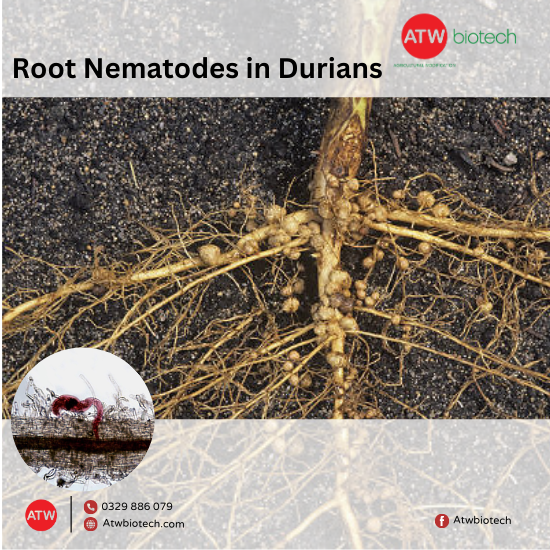
Durian root parasitic nematode 2 months
2. Symptoms of Infestation.
a. Leaf Signs:
- Poor New Shoot Growth: Leaves lose their luster, and while the tree produces new shoots, they are weak and may drop shortly after emerging.
- Color Changes: Durian leaves may turn yellow with interspersed yellow, brown, red, or black spots.
- Deformation: Leaves can curl, twist, or take on irregular shapes.
- Leaf Burn: Leaves may dry out easily and fall prematurely.
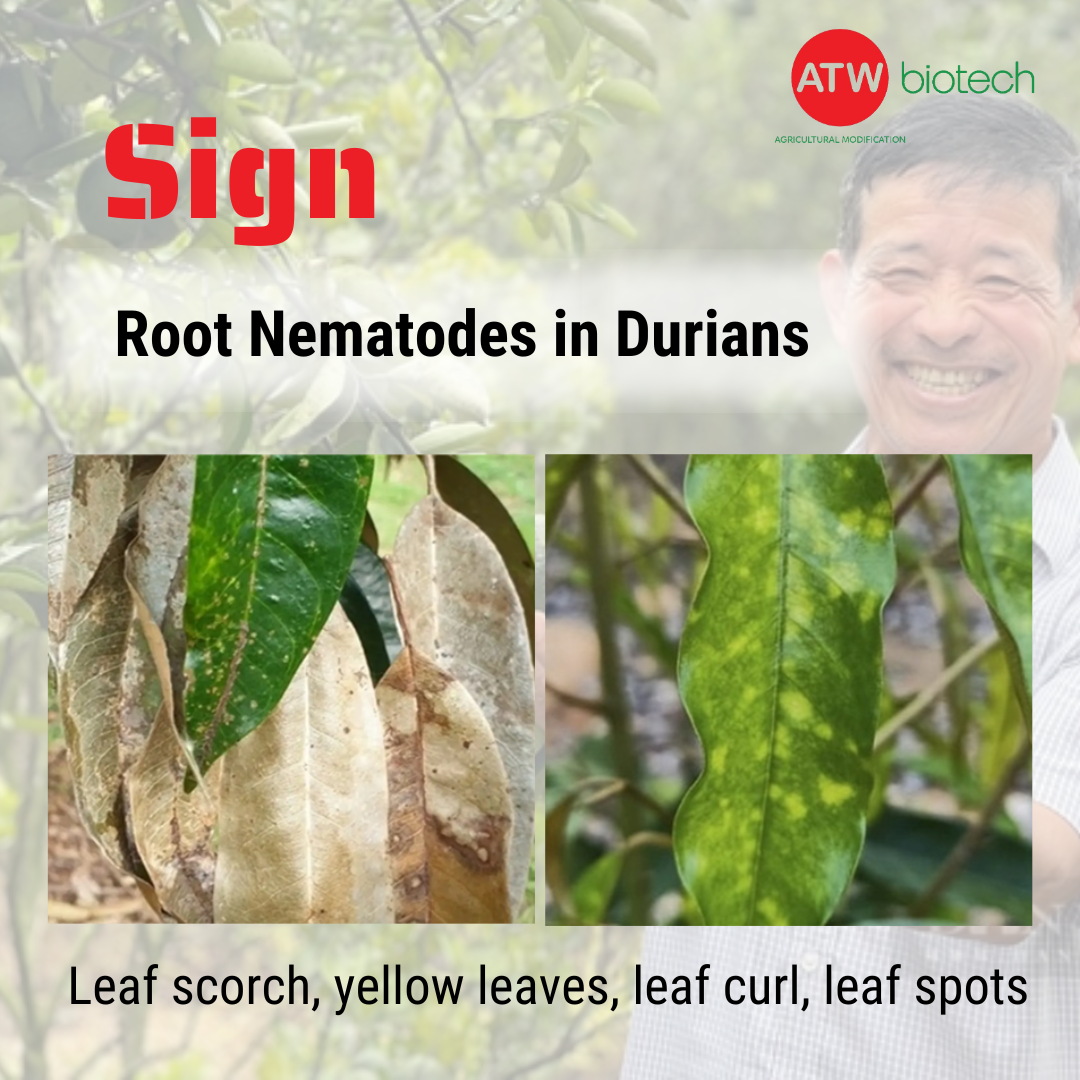
Symptoms on leaves of durian root nematode
b. Stem Signs:
- Stunted Growth: The upper trunk appears slender and narrower compared to the lower part of the tree.
- Wilting: The trunk may show signs of wilting due to poor nutrient and water transport.
- Short Internodes: The distance between leaf nodes is closer together than in healthy, unaffected trees.
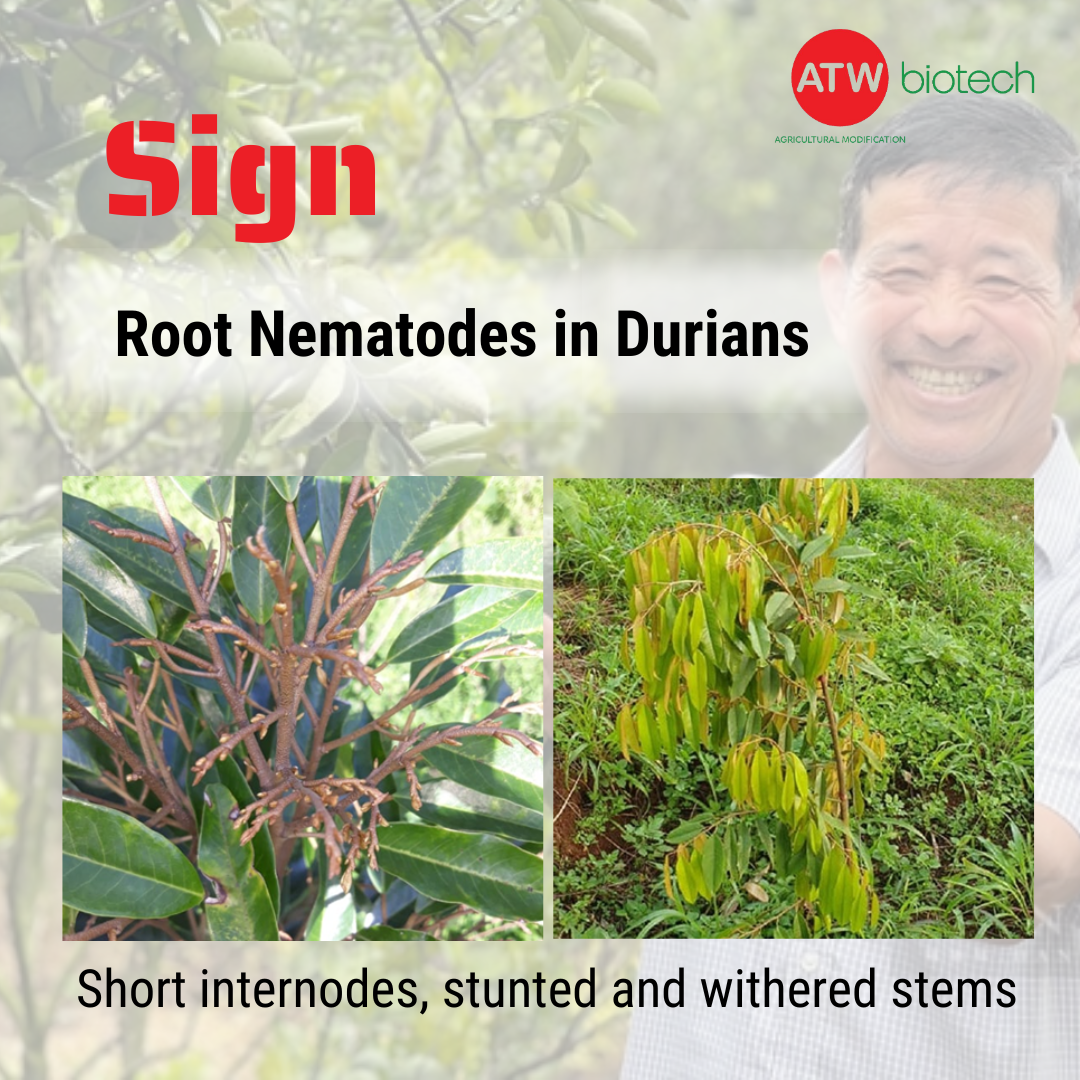
Symptoms on the trunk of durian root nematode
c. Root Signs:
- Root nodules: Roots may develop lumps and swell due to the rapid proliferation of root-knot nematodes.
- Root Rot: Roots can appear brown or black, indicating decay, loss of elasticity, and an unpleasant odor.
- Loss of Root Stability: Roots and the trunk lose their connection, causing instability. This makes the durian tree more susceptible to wind damage and breakage.
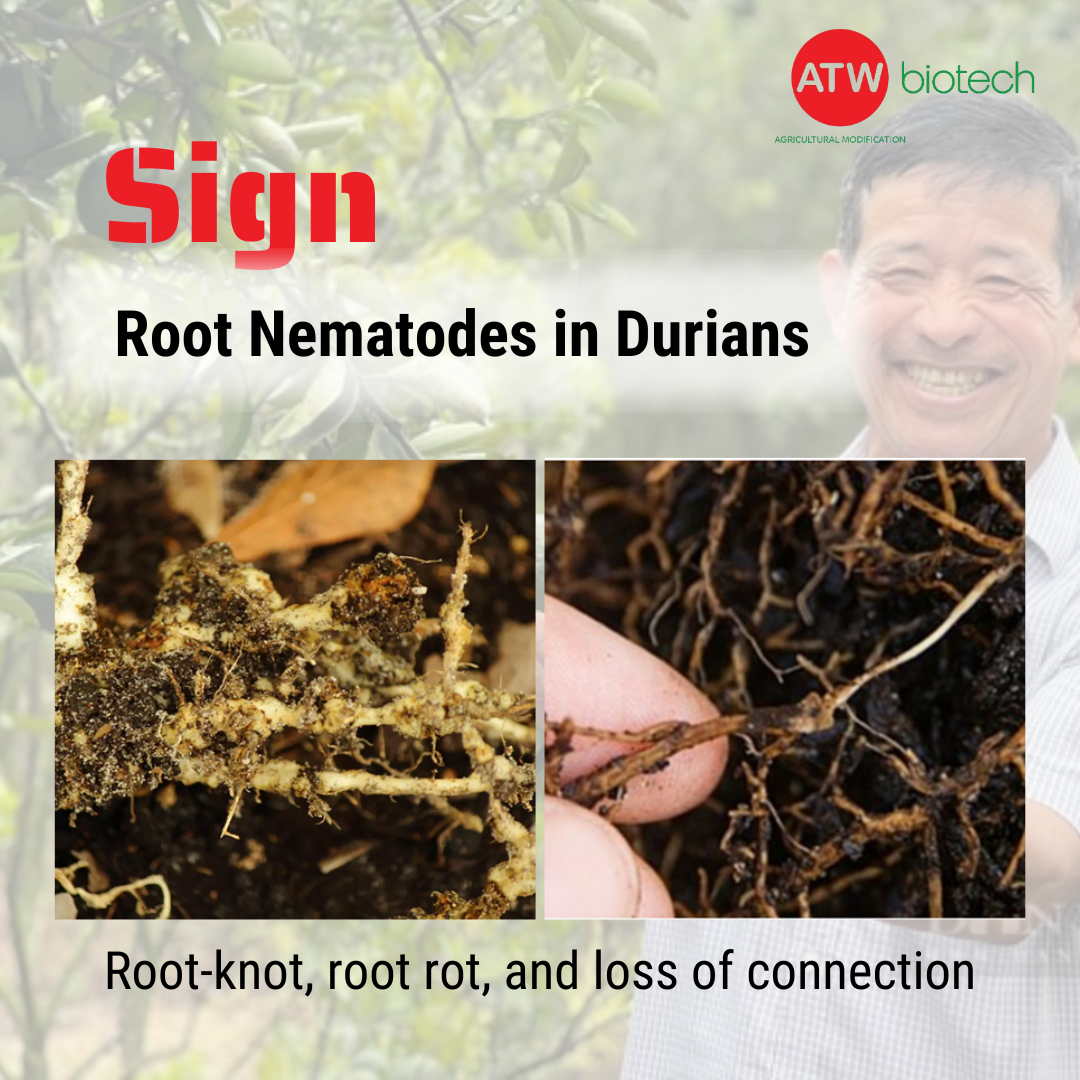
Symptoms on roots of durian root nematode
3. Causes of Nematode Attacks on Durian Fields.
There are several reasons why your durian garden may be affected by root nematodes:
- Excess Moisture and High Humidity: These conditions create an ideal environment for the proliferation of nematodes, fungi, and bacteria.
- Insect Infestations and Pests: Soil insects, such as root grubs and mealybugs, can damage the roots. Certain fungi and bacteria can create injuries in the plant, allowing nematodes to invade more easily.
- Reusing Soil: Using soil that has not been properly treated may harbor existing nematodes and harmful fungi and bacteria.
- Imbalanced Fertilization: Improper use of fertilizers, especially an excess of nitrogen, can lead to root and stem cracking, reducing the plant's resistance and making it more susceptible to nematode attacks.
4. Effect of Root Nematodes in Durians.
Root nematodes can have several detrimental effects on durians:
- Poor Nutrient Transport: Root nematodes invade the root system, damaging root tissues and obstructing the transport of water and nutrients. This can lead to symptoms like yellowing leaves and root rot, ultimately weakening the tree, causing leaf curl, and resulting in bud death.
- Reduced Flower and Fruit Set: Durian trees affected by root nematodes tend to produce fewer flowers and fruits, and any developing fruits may not reach maturity. This can also lead to fruit rot, significantly impacting the yield and quality of the harvest.
- Decreased Fruit Quality: Infected durian fruits may become misshapen and unattractive, reducing their commercial value and adversely affecting the income of durian growers.
- Increased Disease Susceptibility: The damage caused by root nematodes creates injure for other pathogenic fungi to invade the roots. This weakens the tree’s resistance, making it more vulnerable to pests and diseases.
5. Effective Measures for Managing Root Nematodes in Durians.
The best approach to managing root nematodes in durian trees is through prevention. It’s crucial for growers to implement preventive measures at the right time, using proper techniques and appropriate products to minimize damage from nematodes.
For durian orchards that are already affected by nematodes, the treatment will depend on the severity of the infestation. To effectively manage root nematodes and ensure healthy tree growth, three key actions should be taken simultaneously:
- Eliminate Disease Sources: Thoroughly remove any sources of infection to prevent further spread of nematodes.
- Restore and Stimulate Damaged Roots: Focus on rehabilitating the root system that has been compromised by nematode activity.
- Improve Soil Conditions: Enhance soil quality to prevent compaction caused by nematodes, ensuring a healthier environment for root growth.
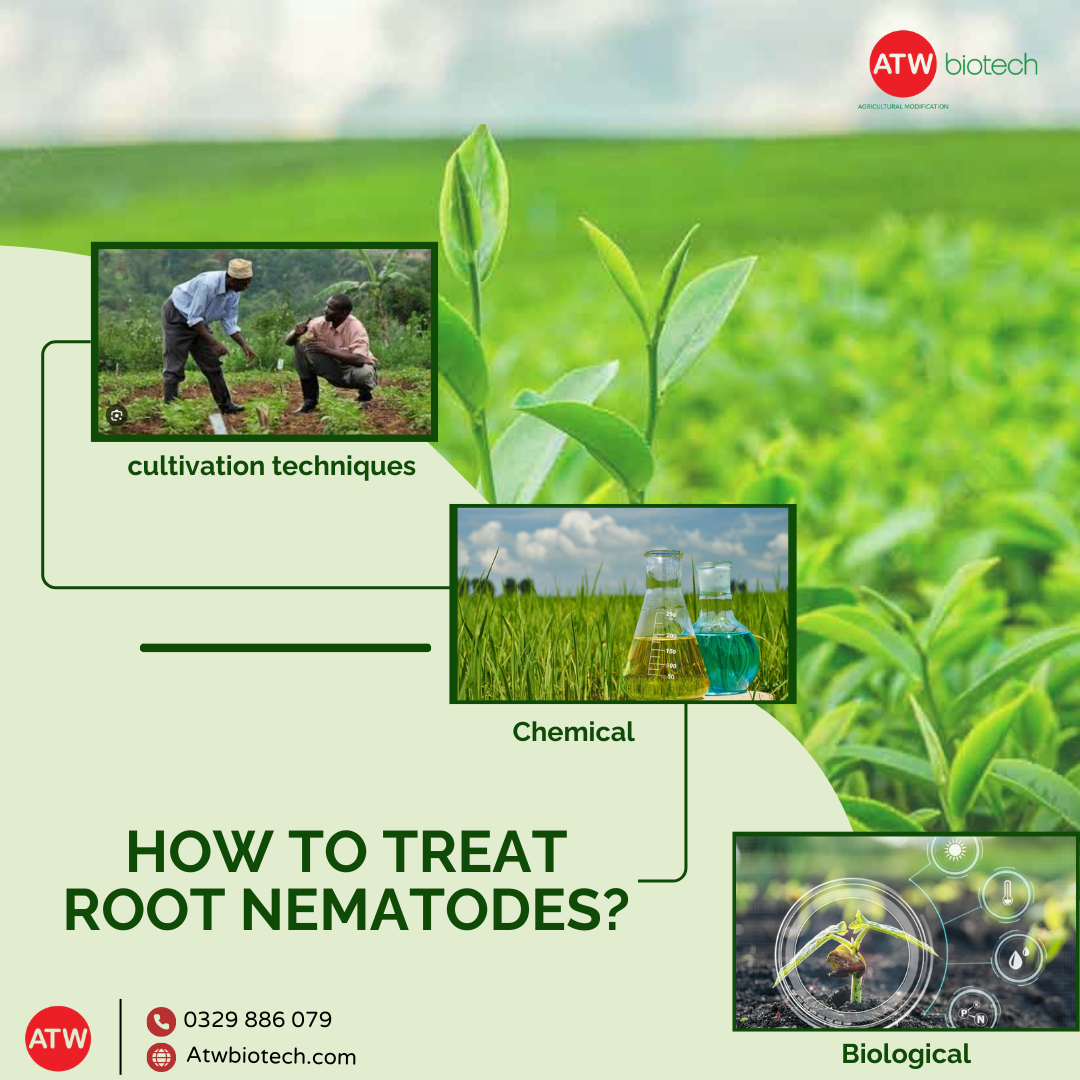
How to treat Root Nematodes
For specific assistance, growers can reach out to the hotline at 0329 886 079 for support from our engineers. Alternatively, consider the following preventive methods:
a. Disease Prevention Through Cultivation Techniques.
- Intercropping: Implement crop rotation and intercropping with other plants to reduce nematode populations.
- Seed Selection: Choose clean durian varieties that have resistance to diseases.
- Cover Crops: Plant cover crops around the root zone of durian trees to disperse nematode attacks. These crops help retain soil moisture and support beneficial microorganisms. Effective options include legumes, marigolds, and wild neem, which can repel nematodes.
- Regular Orchard Inspections: Frequently check your orchard for symptoms of root nematode infestation and monitor soil pH levels for potential acidification.
- Immediate Action on Infestation: If signs of nematodes are detected, promptly remove and destroy infected plants, especially their roots, by burning or applying lime to prevent disease spread to healthy trees.
- Fertilization Practices: Enhance soil health by applying well-composted organic fertilizers with Trichoderma fungi. Additionally, ensure that essential micronutrients are included while minimizing the use of high-nitrogen chemical fertilizers.
- Nematode Control Products: Use specialized nematode treatments according to the recommended dosages for effective control.
b. Chemical Treatment for Root Nematodes.
- Active Ingredients: Products containing active ingredients such as Abamectin, Fosthiazate, Benfuracarb, and Ethoprophos are effective in eliminating both eggs and adult root nematodes in durian trees. Farmers can find commercially available products containing these compounds.
- Effectiveness and Caution: Chemical treatments are known for their rapid effectiveness against nematodes. However, these products do not improve soil health and can lead to soil compaction and root damage. Additionally, they may have long-term adverse effects on crops, soil health, and human health. Therefore, farmers should carefully consider the implications before using these chemicals.
c. Biological Treatment for Root Nematodes.
While chemical treatments can quickly eliminate root nematodes in durian trees, their long-term consequences can be detrimental, and they often fail to eradicate residual pathogens.
As a result, scientists are increasingly focused on developing agricultural products that are effective, sustainable, and safe. Today, bioproducts such as microbial fertilizers and biological pesticides have become familiar allies for farmers, helping to manage diseases in durian trees.
Among the biological nematode control products, Padave 106 WP stands out as a trusted solution in the Central Highlands. This product has been effective, safe, and long-lasting, saving millions of hectares of durian orchards over 14 years on the market.
Padave not only targets root nematodes by eliminating pathogens at all life stages eggs, larvae, and adults, but it also improves soil health and promotes root development in durian trees. This makes it an excellent 3-in-1 solution for farmers.
The biological product Padave can be highly effective in preventing root nematodes and is compatible with aerial application techniques, making it suitable for large-scale durian orchards. By choosing sustainable options like Padave, farmers can ensure the health and productivity of their durian trees.
--------------------------------------------------------------------------------------------
Conclusion:
Root nematodes have caused significant adverse effects on durian trees specifically and crops in general, greatly impacting the agricultural sector in our country.
In this article, Atw has provided insights on how to identify root nematodes in durian trees through various symptoms observed on leaves, stems, and roots.
This information empowers farmers to choose appropriate management strategies for their orchards. For specific advice, farmers can contact our support engineers 24/7 at the hotline 0329 886 079.




